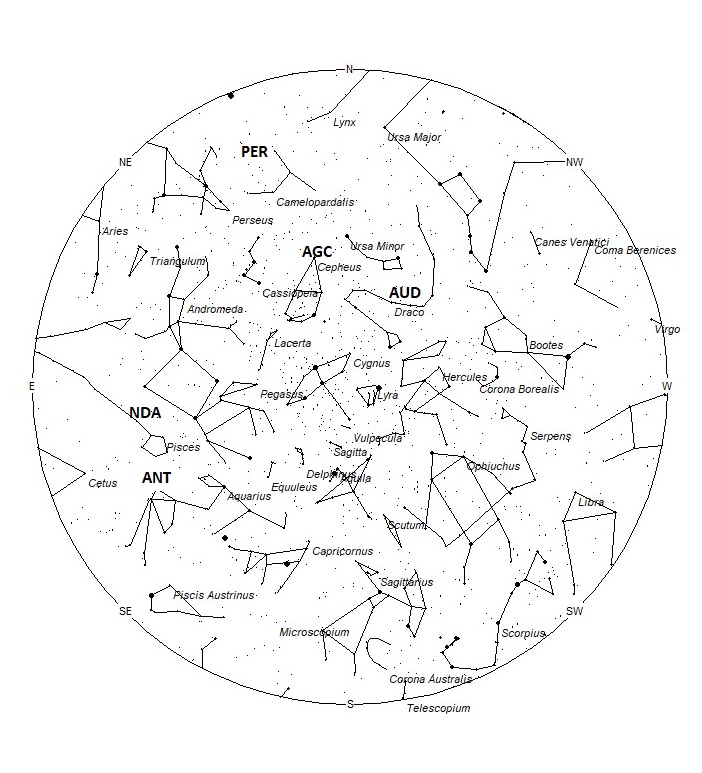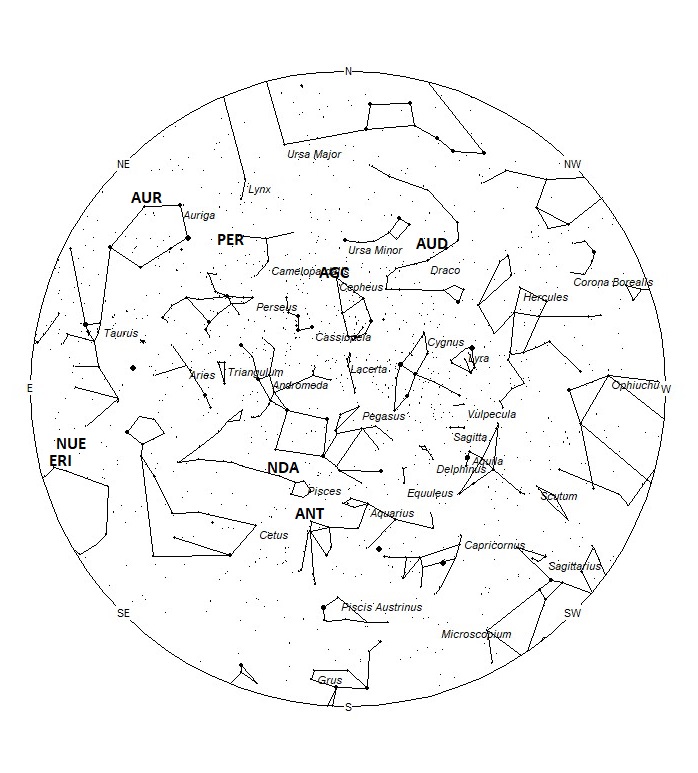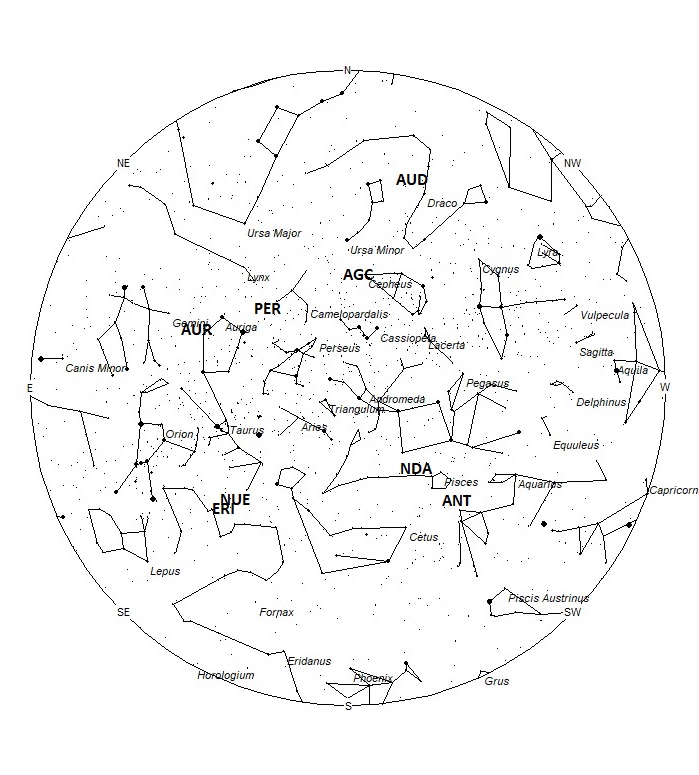
September offers longer nights in the northern hemisphere that tend to be less hazy than those experienced in mid-summer. In the sky, no major showers are visible from either hemisphere, but the northern hemisphere enjoys the advantage of higher sporadic rates. Most of the shower activity this month is produced from the Perseus-Aurigid complex active this time of year. These showers rarely produce more than 5 meteors per hour but still manage to produce most of the shower activity seen this month. Unfortunately, the Perseus-Aurigid complex lies too low in the northern sky for southern hemisphere observers to view very well. Video studies have shown that the Taurids are visible as early as September 28th, therefore after this date the Anthelion radiant will no longer be listed until the Taurid showers end in December. The Anthelion meteors are still active but their radiant is superimposed upon that of the more numerous Taurids, therefore it is impossible to properly separate these meteors. Observers in the southern hemisphere suffer from some of their lowest rates of the year this month. The Taurid radiants are not too badly placed so observers south of the equator can expect to see a little of this activity from this source this month.
During this period, the moon reaches its last quarter phase on Monday August 30th. At that time the moon lies 90 degrees west of the sun and rises near 23:00 local daylight saving time (LDST) on Sunday August 29th. During this period evening skies will be free of interfering moonlight, but morning observers must take care to avoid the moon within their field of view. The moon rises later with each passing night enlarging the window of opportunity to view meteor activity under darker skies. The estimated total hourly meteor rates for evening observers this week is near 4 as seen from mid-northern latitudes (45N) and 3 as seen from tropical southern locations (25S). For morning observers, the estimated total hourly rates should be near 12 as seen from mid-northern latitudes (45N) and 8 as seen from tropical southern locations (25S). The actual rates will also depend on factors such as personal light and motion perception, local weather conditions, alertness, and experience in watching meteor activity. Morning rates are reduced this week due to interfering moonlight. Note that the hourly rates listed below are estimates as viewed from dark sky sites away from urban light sources. Observers viewing from urban areas will see less activity as only the brighter meteors will be visible from such locations.
The radiant (the area of the sky where meteors appear to shoot from) positions and rates listed below are exact for Saturday night/Sunday morning August 28/29. These positions do not change greatly day to day so the listed coordinates may be used during this entire period. Most star atlases (available at science stores and planetariums) will provide maps with grid lines of the celestial coordinates so that you may find out exactly where these positions are located in the sky. I have also included charts of the sky that display the radiant positions for evening, midnight, and morning. The center of each chart is the sky directly overhead at the appropriate hour. These charts are oriented for facing south but can be used for any direction by rotating the charts to the desired direction. A planisphere or computer planetarium program is also useful in showing the sky at any time of night on any date of the year. Activity from each radiant is best seen when it is positioned highest in the sky, either due north or south along the meridian, depending on your latitude. It must be remembered that meteor activity is rarely seen at the radiant position. Rather they shoot outwards from the radiant, so it is best to center your field of view so that the radiant lies at the edge and not the center. Viewing there will allow you to easily trace the path of each meteor back to the radiant (if it is a shower member) or in another direction if it is sporadic. Meteor activity is not seen from radiants that are located far below the horizon. The positions below are listed in a west to east manner in order of right ascension (celestial longitude). The positions listed first are located further west therefore are accessible earlier in the night while those listed further down the list rise later in the night.
These sources of meteoric activity are expected to be active this week.
.
The zeta Draconids (AUD) were discovered by Zdenek Sekanina in his study of meteor streams using radio methods. This stream is active from August 12-September 5 with maximum activity occurring on August 26. The radiant is currently located at 16:40 (250) +62, which places it in central Draco, 2 degrees northeast of the 4th magnitude star known as Athebyne (eta Draconis A). This radiant is best placed near 2200 LDST, when it lies on the meridian and is located highest in the sky. With an entry velocity of 21 km/sec., the average zeta Draconid meteor would be of slow velocity. Rates this week are expected to be less than 1 no matter your location. Due to the high northern declination these meteors are difficult to observe from the southern hemisphere. These meteors are synonymous with the August Draconids (AUD).
The center of the large Anthelion (ANT) radiant is currently located at 23:12 (348) -05. This position lies in northeastern Aquarius, 1 degree north of the 4th magnitude star known as phi Aquarii. Due to the large size of this radiant, Anthelion activity may also appear from western Pisces as well as Aquarius. This radiant is best placed near 0100 LDST, when it lies on the meridian and is located highest in the sky. Rates at this time should be near 2 per hour no matter your location. With an entry velocity of 30 km/sec., the average Anthelion meteor would be of slow velocity.
The August gamma Cepheids (AGC) are a recent discovery by Damir Šegon and the Croatian Meteor Network team based on studying SonotaCo and CMN observations (SonotaCo 2007-2011, CMN 2007-2010). Meteors from this source are expected from August 17 through September 6, with maximum activity occurring on August 29. The current position lies at 23:55 (359) +77, which lies in eastern Cepheus, 2 degrees north of the 3rd magnitude star known as Errai (gamma Cephei A). This radiant is best placed near 0200 LDST, when it lies on the meridian and is located highest in the sky. Rates at this time should be less than 1 per hour as no matter your location. With an entry velocity of 44 km/sec., the average meteor would be of medium velocity. These meteors are not visible south of latitude 20 South.
The August beta Piscids (NDA) are part of the Northern delta Aquariid complex, active from August 18-September 8. This second peak of the NDA’s occurs on August 21st, when the radiant lies well within the boundaries of the constellation of Pisces. The radiant currently lies at 23:56 (359) +08, which is located in western Pisces, 2 degrees north of the 4th magnitude star known as omega Piscium. This radiant is best placed near 0200 LDST, when it lies on the meridian and is located highest in the sky. Hourly rates at this time should be less than 1 no matter your location. With an entry velocity of 38 km/sec., the average meteor from this source would be of medium velocity.
The nu Eridanids (NUE) were co-discovered by Japanese observers using SonotoCo and Jürgen Rendtel and Sirko Molau of the IMO. Activity from this source stretches from August 31 to September 21. The main maximum activity occurs on September 10th. A secondary maximum occurs on September 17th. The radiant currently lies at 03:54 (058) -04, which places it in northeastern Eridanus, near the faint star known as 32 Eridani. Note that this position is close to the radiant of the eta Eridanids. One must face the radiants of these two sources to separate them. This area of the sky is best seen during the last dark hour before dawn when the radiant lies highest in a dark sky. Current rates are expected to be less than 1 per hour during this period no matter your location. With an entry velocity of 65 km/sec., the average meteor from this source would be of swift velocity.
The eta Eridanids (ERI) are active from a radiant near 04:00 (060) -07. This position lies in northern Eridanus, 3 degrees west of the magnitude star known as Beid (omicron1 Eridani). This source is active until September 10th, with maximum activity occurring on August 6th. Current rates would be less than 1 per hour no matter your location. These meteors are best seen during the last dark hour prior to dawn when the radiant lies highest above the horizon in a dark sky. With an entry velocity of 64 km/sec., the average meteor from this source would be of swift speed.
The last of the Perseids (PER) will be seen this week from a radiant located at 04:51 (073) +60. This position lies in southern Camelopardalis, 2 degrees southwest of the 4th magnitude star known as beta Camelopardalis. This area of the sky is best placed for viewing during the last dark hour before dawn when it lies highest in the sky. Current hourly rates are expected to be less than 1 no matter your location. With an entry velocity of 59 km/sec., the average meteor from this source would be of swift velocity.
The Aurigids (AUR) are active from August 28 through September 4, peaking on August 31st (Universal Time). At maximum the radiant is located at 06:04 (091) +39. This position lies in eastern Auriga, 2 degrees northeast of the 3rd magnitude star known as Mahasim (theta Aurigae A). This area of the sky is best seen during the last dark hour before dawn when the radiant lies highest in a dark sky. Normally, hourly rates are less than 1 except on the night of maximum activity. This year there is the possibility of an outburst occurring between 21:15 and 21:45 UT. This timing favors Asia and northeastern Europe. Zenith hourly rates of 50-100 are predicted within this timeframe. Unfortunately, a waning crescent moon will be located in the same region of the sky as Auriga, therefore observed rates are bound to be considerably less. With an entry velocity of 65 km/sec., the average meteor from this source would be of swift velocity.
As seen from the mid-northern hemisphere (45N) one would expect to see approximately 10 sporadic meteors per hour during the last hour before dawn as seen from rural observing sites. Evening rates would be near 3 per hour. As seen from the tropical southern latitudes (25S), morning rates would be near 6 per hour as seen from rural observing sites and 2 per hour during the evening hours. Locations between these two extremes would see activity between the listed figures. Morning rates are reduced due to moonlight.
|
SHOWER |
DATE OF MAXIMUM ACTIVITY | CELESTIAL POSITION | ENTRY VELOCITY | CULMINATION | HOURLY RATE | CLASS |
| RA (RA in Deg.) DEC | Km/Sec | Local Daylight Saving Time | North-South | |||
| zeta Draconids (AUD) | Aug 26 | 16:40 (250) +62 | 22 | 20:00 | <1 – <1 | IV |
| Anthelion (ANT) | – | 23:12 (348) -05 | 30 | 02:00 | 2 – 2 | II |
| August gamma Cepheids (AGC) | Aug 29 | 23:55 (359) +77 | 43 | 03:00 | <1 – <1 | IV |
| August beta Piscids (NDA) | Aug 21 | 23:56 (359) +08 | 38 | 03:00 | <1 – <1 | IV |
| nu Eridanids (NUE) | Sep 10 | 03:54 (058) -04 | 65 | 07:00 | <1 – <1 | IV |
| eta Eridanids (ERI) | Aug 06 | 04:00 (060) -07 | 64 | 07:00 | <1 – <1 | II |
| Perseids (PER) | Aug 13 | 04:51 (073) +60 | 59 | 08:00 | <1 – <1 | I |
| Aurigids (AUR) | Aug 31 | 06:04 (091) +39 | 65 | 09:00 | ? | III |
 American Meteor Society
American Meteor Society



I’d like to ask a question, Robert. I’m a member of the IMO and would like to make more contributions to their database, especially for the minor showers that aren’t well observed. My concern is that the instructions that I’ve seen to make a scientifically valuable meteor count state that my limiting magnitude has to be better than 5.0, and I’m wondering if observations made when the LM is slightly lower, say, 4.5 – 4.0, are worthless. For example, I’d like to get out and do a count of the upcoming Aurigid shower, weather permitting. But the Moon will probably not let me attain a dark enough sky for 5.0 magnitude stars to be seen. Would it be worthwhile to send in a report to the IMO anyway? Thanks in advance. I emailed the IMO about this a couple of weeks ago, but have received no reply.
I saw a huge, wide swath, like a wide ribbon dash broadly across sky this morning 8/30/21. Unlike anything I have ever witnessed or seen in pictures.